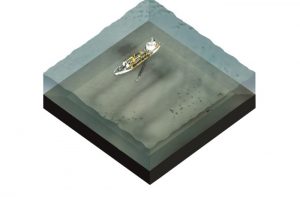How to Use
This section describes and gives guidance to the steps to be taken to design landscaping of the seabed on basis of ecosystem approach. The steps are described following the BwN design steps:
1. Understand the system
Shallow sand extraction
In general, sand extraction has direct impacts. Benthic organisms are damaged or removed and bathymetry and sediment composition may change considerably. Indirect effects vary from increased suspended matter and turbidity and detrimental effects on filter-feeders, predatory fish and the food web.
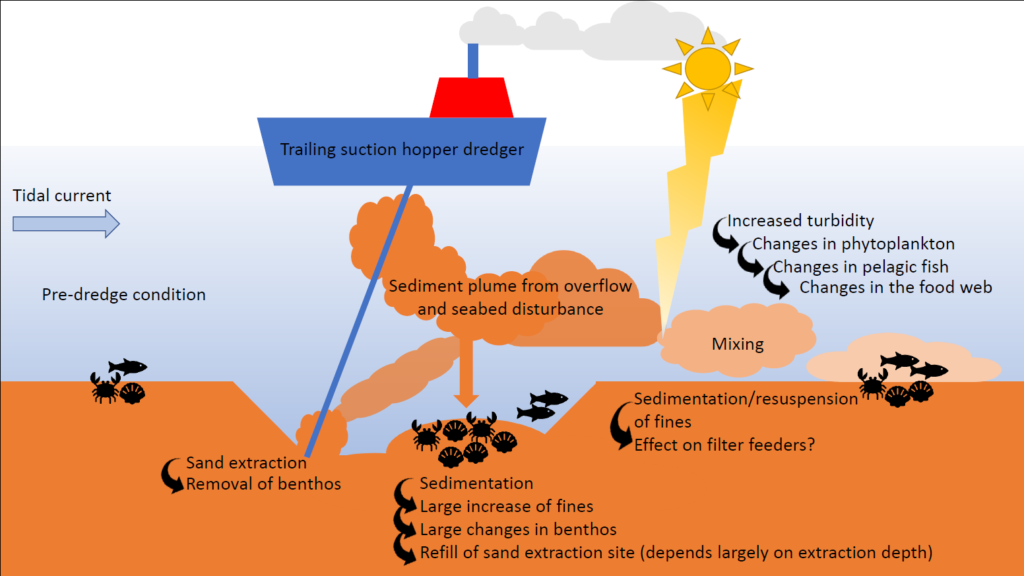
Until a few years ago, the focus of ecological research was mainly on the on the direct effects of sand extraction. For shallow sand extraction depths, up to -2 m below the original seabed on the Dutch Continental, in general recovery of macrozoobenthos back to pre-disturbance conditions occurs in 2-4 year. For surrounding areas similar recovery times are reported.
Differences in recovery time exists, for shallow coarse sediments with weak tidal bed shear stress a recovery time of 11 year was found (Wan Hussin et al. 2012). Recovery times for dredged estuarine muddy areas are found to be around 6-8 months (Newell et al. 2008). Recovery times of areas with reef building organisms such as the sand mason worm (Lanice conchilega), honeycomb worm (Sabellaria alveolate) or long-living organism such as the ocean quahog (Arctica islandica) would be in the order of decades even after shallow sand extraction.
In general, demersal fish are closely linked to macrozoobenthos which can be severely influenced by sand extraction. In France, it was found that aggregate extraction can also lead to new seabed habitats which may favour certain macrozoobenthic and demersal fish species (Desprez et al. 2000). Fishing fleets near aggregate extraction sites were not deterred and fishing effort of potters and English dredgers were positively related to extraction intensity Marchal et al. 2014). Sand extraction sites may even attract marine mammals (Todd et al. 2014).
Deep sand extraction
It appeared that in the Netherlands there is little experience with the effects of deep sand extraction sites on existing values and user-functions, due to Dutch legislation prior to 2000. In 2000, possibilities of extraction depths larger than 2 m below the seabed were explored (Boers 2005). It became clear that in water depths of less than 40 m, the chance of reduced seawater oxygen content is rather small and that re-establishment of organisms on the seabed is possible.
Baseline data from the Port of Rotterdam which was collected in 2006 and 2008 in a 2500 km2 large research area showed that the benthic system can be changed considerably by sand extraction and sediment disposal and that these changes persists in time (De Jong et al. 2015).
More information on the effects of sand extraction can be found in Tool – Ecosystem-based Design Rules for Sand Extraction Sites and Case – Ecosystem-based design of sand extraction sites – Pilot MV2 Sand Extraction site.
2. Identify realistic alternatives
a) assumptions in the approach of landscaping
Based on literature, it is recognised that differences in the (chemical – physical) habitat is reflected in differences in community composition. Colonisation of areas will be an ongoing process, but follows the physical starting point. After a certain period, some organisms may be capable to influence their environment (eco-engineers) causing a reverse situation in which some physical parameters will follow the community development.
Important chemical-physical parameters are: salinity and dissolved oxygen content of seawater, sediment organic matter and silt content, sediment grainsize distribution, the existence of ‘hard’ substrate and seabed morphology. Most of these parameters are interrelated, being the result of transport mechanisms or existing energy at a certain location. A good indicating parameter for energy is bed shear stress. Relevant ecological parameters are species composition, species richness, diversity and biomass and could be determined for the infauna, the epifauna and demersal fish. Species composition has relevance to life history, age structure and feeding traits. Bed shear stress is linked with in- and epifaunal and demersal fish species composition (De Jong et al. 2014, De Jong et al 2015a, De Jong et al. 2015b). Bed shear stress is directly related to the extraction depth of sand extraction and can therefore be used in the design of extraction sites.
b) guidelines and boundary conditions
A top-down approach to determine the feasibility and design of a landscaped ecological sand extraction site is made along 3 steps. First, the feasibility of a landscaped ecological sand extraction site is determined using rules-of-thumb. Then a preliminary design of the landscaped ecological sand extraction site is determined using simple tools and parameterizations. The basic design can then be optimized in a detailed assessment using process-based models (3D hydrodynamical models) and species response curves and habitat rules.
Step 1: determine the feasibility of landscaping an ecosystem-based sand extraction site.
- determine the location of the extraction site, the total extractable volume, and existing legislation and potential objections to ecological sand extraction.
- determine the characteristics of the extraction site (sediment characteristics, hydrodynamics, sediment transport, morphology, ecology etc.)
- make designs for a regular sand pit and a design for a deep pit with an extraction depth of about 8 to 30 m and a design for the deep pit with ecosystem-based sand bars.
- determine the life span of the designs, cost for implementing, safety issues and potential for ecosystem-based sand extraction.
Step 2: determine a basic design for landscaping an ecosystem-based sand extraction site
- choose design scenario (to increase biodiversity or biomass etc.).
- determine criteria for evaluation, what result is required to make the project a success?
- determine the most descriptive and influencing abiotic parameter(s) for ecological development. Changing this parameter(s) will determine the chance of successfully creating habitat conditions for the preferred post-dredge situation.
- create and compare histograms of time-averaged bed shear stresses for the traditionally and ecosystem-based landscaped sand extraction site designs using formulae for bed shear stresses under uniform flow. Assuming time-averaged bed shear stresses to be the most descriptive and deterministic abiotic parameter(s) for ecological development.
Step 3: optimize the design for an ecosystem-based landscaped ecological sand extraction site
- set-up and run a process-based hydrodynamic, water quality, sediment transport and morphological models of the regular sand extraction site design and the ecosystem-based sand extraction site, extract year-averaged bed shear stresses, dissolved oxygen levels, organic matter and mud content and seabed morphology.
- determine future ecological response using classification schemes, habitat rules, species response curves or other statistical approaches.
- iteratively optimize the ecosystem-based design based on the design scenario scores.
c) determine the feasibility of an ecosystem-based sand extraction site
The basis for an extraction design is the amount of marine sand needed and the quality. Other practical considerations are also important, for instance legislation, economical aspects (sailing distance) and the method of extraction. This leads to a reconnaissance of potential areas that can provide these conditions. The selected extraction site can be characterized by location (orientation, depth), hydrodynamics (waves, currents), sediment (transport, -type, -distribution, percentage organic matter, stratigraphy), morphology (sand waves or sand ridges) and ecology (assemblage). Given the characteristics of the area, a preliminary design of the ecosystem-based sand extraction can be determined, considering a number of technical, physical, and ecological parameters. The life span of the design, the costs for implementing, safety issues and potential of ecosystem-based sand extraction should be determined .
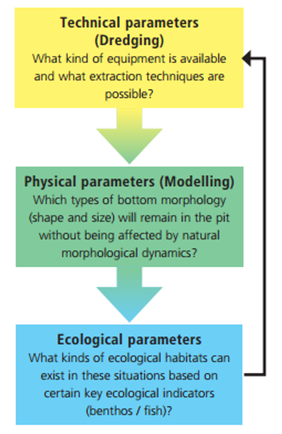
Technical parameters
Trailer Suction Hopper Dredgers (TSHD’s) are the most efficient tool for sand extraction and they vary in size and capacity. To avoid unnecessary high cost and loss of time, several technical parameters have to be taken into account when designing an ecosystem-based extraction site.
| Technical parameter | Description | Reference |
|---|---|---|
| Dredging depth | The maximum dredging depth of the TSHDs should be considered to avoid excessive cost and loss of time. Only a few TSHDs can create deep troughs. | Rijks, 2011 |
| Manoeuvrability | The manoeuvrability of the ships to create specific shapes should be considered to avoid excessive cost and loss of time. The sharper the shapes, the more time it will take to create. | Rijks, 2011 |
| Capacity | The capacity of the ships and the specific sailing lengths to fill the hopper should be taken into account to avoid excessive cost and loss of time. The smaller the shapes, the less likely TSHDs will reach an optimal dredging volume during one track and thereby increasing dredging effort and cost. | Rijks, 2011 |
| Hydraulic conditions | For economic and technical reasons shapes should preferably not lie perpendicular to the main current directions as ships and dredging operations are limited under these circumstances, increasing time and costs. | Rijks, 2011 |
Physical parameters
| Physical parameter | Description | Reference |
|---|---|---|
| Location | The location determines the characteristics of the extraction site including hydrodynamics, metocean and geotechnical conditions, sediment transport, morphology and ecology. | Rijks, 2011 |
| Shape | The shape of the extraction site is often determined by other user functions. The shape will determine what kind of ecosystem-based bed form design can be planned in the extraction site. | Rijks, 2011 |
| Sediment | The extraction site needs to contain sufficient sand of the desired grain size. The natural variation in grain sizes and percentage fines can be used in the creation of different landscapes and related ecological habitats. If needed, overflow from dredging equipment can be stimulated to ensure that more fines are left behind in certain areas for the development of specific habitats. | Rijks, 2011 |
| Morphology | The occurrence and dimensions of naturally existing morphological bed forms in the wider extraction area can be copied in the extraction site although they may need another orientation with regards to the tidal current. | Rijks, 2011 |
| Infrastructure | The presence of wrecks, cables and pipelines determine the shape of the extraction site and ecosystem-based bed forms. | Rijks, 2011 |
Ecological parameters
Ideally, the dredged seabed has variation in substrate composition (grain size, mud and organic matter content)and containing series of bed forms with variation in steepness and orientation with regards to the tidal current. Each combination will be tailor made to create a certain ecological habitat. This means that the relation between seabeds, via hydrodynamics and physics, and ecology must be clear when determining the goals of ecosystem-based landscaping. Knowledge on the relationship between marine organisms and sediment characteristics, water depth, hydrodynamics, sediment transport and morphology is the subject of a PhD study within the Building with Nature programme. Preliminary results indicate that the sediment characteristics and time-averaged bed shears stresses are important parameters determining ecological response and therefore of use in the design of ecosystem-based seabeds (De Jong et al. 2015).
3. Valuate the qualities of alternatives and pre-select an integral solution
a) determine a basic design for a landscaped ecological mining pit
The results presented in a report (Tonnon, 2013) and study (De Jong et al. 2015b) support the hypothesis that ecosystem-based landscaping increases biodiversity in the sand extraction site. Moreover, based on the bed shear stress, a distinction could be made between two clusters (the Albra alba assemblage and the Echinoidea spp. – phoronidea assamblage). The Albra assemblage was roughly found in areas having a bed shear stress smaller than 0.4 N m-2 and the Echinoidea spp. – phoronidea assemblage was roughly found at bed shear stresses larger than 0.4 N m-2.
Ecological data and bed shear stress values were transformed into ecosystem-based design rules for the Dutch Continental Shelf. At higher flow velocities and larger water depths, larger extraction depths can be applied to achieve desired tide-averaged bed shear stresses for related ecological effects (De Jong et al., 2016). The Ecosystem Based Design (EBD) rules can be used in the early-design phases of future sand extraction sites to simultaneously maximise sand yields and decrease the surface area of direct impact. The EBD rules and ecological landscaping can also help in implementing the European Union’s Marine Strategy Framework Directive (MSFD) guidelines and moving to or maintaining Good Environmental Status (GES).
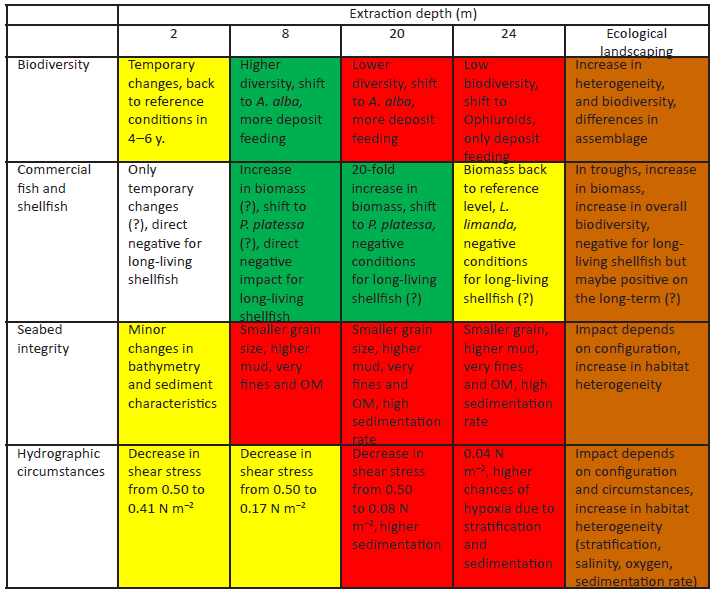
More detailed information of the EBD-rules can be found in Ecosystem-Based Design Rules for Sand Extraction Sites
b) ecosystem-based design rules for the minimum excavation depth ecological mining sites
Based on the simple calculation rules for the computation of depth-averaged velocities and time-averaged bed shear stresses recommendations can be obtained for a minimum excavation depth of ecological sand extraction sites along the Dutch coast. Given a pre-extraction water depth and depth-averaged peak flow velocity, the minimum excavation depth resulting in time-averaged bed shear stresses of about 0.4 N m-2 in the bottom of the sand extraction site can be determined from figure 5. This figure gives minimal excavation depths (resulting in time-averaged bed shear stresses in the bottom of the pit of about 0.4 N m-2) as a function of water depth for depth-averaged peak flow velocities of 0.55, 0.65 and 0.75 m s-1. Given the extraction volume, the length and width of the ecological mining pit can be chosen subsequently.
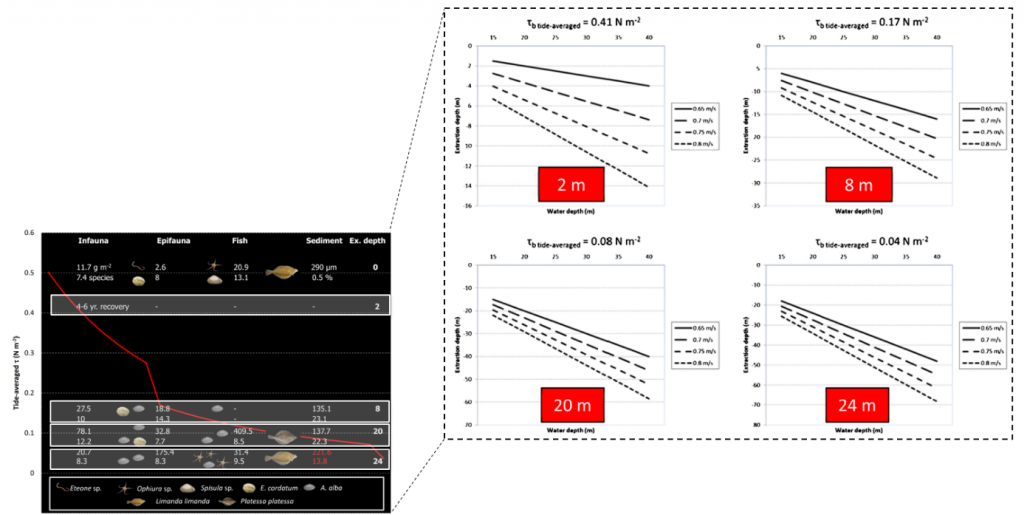
With the design graph, the minimum excavation depth of can easily be determined. The total area of the mining pit can then be computed by dividing the required sand extraction volume by the excavation depth. From the total area of the sand extraction site, the length and width of the extraction site can be selected based on available space and restrictions.
- Step 1: Determine the water depth and depth averaged peak-flow velocity in the extraction area. Along the Dutch coast, the depth-average peak flow velocities (M2 velocity amplitudes) are between 0.55 and 0.75 m s-1 (Third figure in Ecosystem-Based Design Rules for Sand Extraction Sites)
- Step 2: Determine the minimum excavation depth using the design graph.
- Step 3: Compute the surface area of the mining pit by dividing the required extraction volume by the determined sand extraction depth. From the total surface area of the sand extraction site, the length and width of the site can be selected based on available space and restrictions.
4. Elaborate selected alternatives
a) optimize the design for an ecosystem-based landscaped sand extraction site
Using a combination of (field) data, process-based (model) data and ecological analyses, a prediction of macrozoobenthic and demersal fish assemblage distribution for a traditional sand extraction site design and an ecosystem-based landscaped sand extraction site can be made. The design of the ecosystem-based landscaped sand extraction site can iteratively be optimised.
b) determine construction costs for seabed landscaping of sand extraction pit
To assess the (additional) cost for ecosystem-based landscaping the contractors need to be consulted. They can provide information on:
- critical depth thresholds for sand extraction and costs per type of TSHD, as limitations to the maximum extraction depth;
- design boundary conditions for ecosystem-based sand extraction sites based on technical feasibility;
- unit cost for sand extraction or cost function per m3 and sailing distance; the cost for the sand extraction works itself;
- additional cost for ecosystem-based sand extraction projects, like creating deep troughs or leaving shallow crests.

